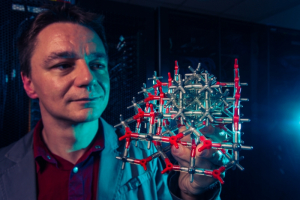Last year, a researcher from the UH Cullen College of Engineering made an amazing discovery. Jiming Bao, assistant professor of electrical and computer engineering, found that cobalt monoxide nanoparticles can be used to split water into hydrogen and oxygen when exposed to sunlight.
Since hydrogen itself is a clean and efficient fuel – whether burned or used in fuel cells to generate electricity – such a finding could drastically reduce our dependence on petroleum. Moreover, Bao found that cobalt monoxide nanoparticles generate about 50-times more hydrogen than traditional catalysts.
Although these findings have enormous implications for industries ranging from energy to electronics, one huge problem remains: we fundamentally do not understand why cobalt monoxide nanoparticles work so effectively as photocatalysts.
But now, thanks to seed funding provided through the University of Houston’s GEAR program, or Grants to Enhance and Advance Research, one Cullen College professor is joining Bao’s team – and together they may be able to find the answer to this looming question. Lars Grabow, assistant professor of chemical and biomolecular engineering, was awarded $30,000 for one year through the GEAR Program to help determine the fundamental science underpinning this mysterious phenomenon. Grabow is the only faculty member within the Cullen College to win this year’s GEAR award.
The mystery surrounding why cobalt monoxide nanoparticles serve so well as photocatalysts starts with their tiny size: just about five to 25 billionths of a meter. When using particles larger than this, cobalt monoxide is completely inactive. But at the nanoscale, this is not the case; suddenly, cobalt monoxide is a viable photocatalyst. Because the electrochemical properties of cobalt monoxide had never been studied at the nanoscale, researchers never knew these tiny particles could be used as photocatalysts.
This is the fundamental science that Grabow hopes to shed some light on through his GEAR-funded research. “Jiming and I have been trying to figure this out, going back and forth about why this would happen,” Grabow explained. “I’d like to join his efforts to get to the bottom of it, and I believe I can provide the theoretical support his team needs in order to be successful and make this system work even better.”
The first step of Grabow’s research will be to determine exactly why cobalt monoxide works so well as a photocatalyst at the nanoscale. Grabow believes that at the nanoscale, cobalt monoxide is capable of splitting water because of its band edge position – essentially, the property that determines its ability to add or remove electrons from water molecules. Large particles of cobalt monoxide have a band edge position which prevents the material from transferring electrons to protons (positively charged hydrogen ions) and reducing them to H2 molecules – but at the nanoscale, Grabow believes the band edge position of cobalt monoxide shifts to more negative potentials, allowing electrons to move to the particle surface and generate hydrogen. At the same time, the generated electron holes can oxidize water, forming O2 and protons.
In order to test this theory, Grabow and his research team will run computer simulations to try to predict how band structure changes as a function of particle size. “We will study particles of different sizes, calculate their electronic structure, extract the band edge positions, and then we want to find the trends: How does the band structure change with particle size? What is the radius at which particle dimensions actually start to matter? Then we can start to predict what is happening with the band structure of other semiconductors as their size shrinks,” Grabow said.
But what if Grabow’s theory on what’s happening with band structure at the nanoscale isn’t correct? “That’s even better,” Grabow said. “If it’s something we’re not expecting at all, that’s even more exciting.” Regardless of what Grabow and his team find out about why electronic structure and band positioning changes at the nanoscale, one thing is certain: his findings will open the door for many other semiconducting materials to be used as photocatalysts.
Previously, researchers have relied only on a semiconductor’s bulk properties to predict whether it will work for a given electronic application, with most research efforts focusing on band gap engineering to create suitable semiconducting materials. Once Grabow finishes his particle-size simulations, though, he hopes that researchers will then have a much larger list of materials that can work as semiconductors at the nanoscale.
Francisco Robles Hernández, assistant professor in the UH College of Technology and a collaborator on this research, will synthesize other types of semiconductors as nanoparticles and test Grabow’s predictions. Grabow believes this fundamental research into the odd and unexpected behaviors of tiny particles can be exploited to the benefit of the entire semiconductor industry. Since semiconductors are used in virtually all modern electronics, these findings could have enormous implications for the electronics industry.
Moreover, Grabow noted that as electronic devices become increasingly smaller, the science underpinning this phenomenon could help electronics manufacturers by widening the array of materials that could be used as semiconductors in very small devices. “If you can predict how these materials and their electronic properties change, then we can help the whole device fabrication industry that uses semiconductors for computer chips or anything else at these very small scales,” he said.
Thanks to the seed funding from UH for this project, Grabow will now have a graduate student working on this research full-time for one year, which he said will help speed up the discovery process. “On top of this award being a great honor, it’s a huge boost for this research,” he said. “I am so excited and have high hopes that this initial boost will help us attract more funding for this project.”
